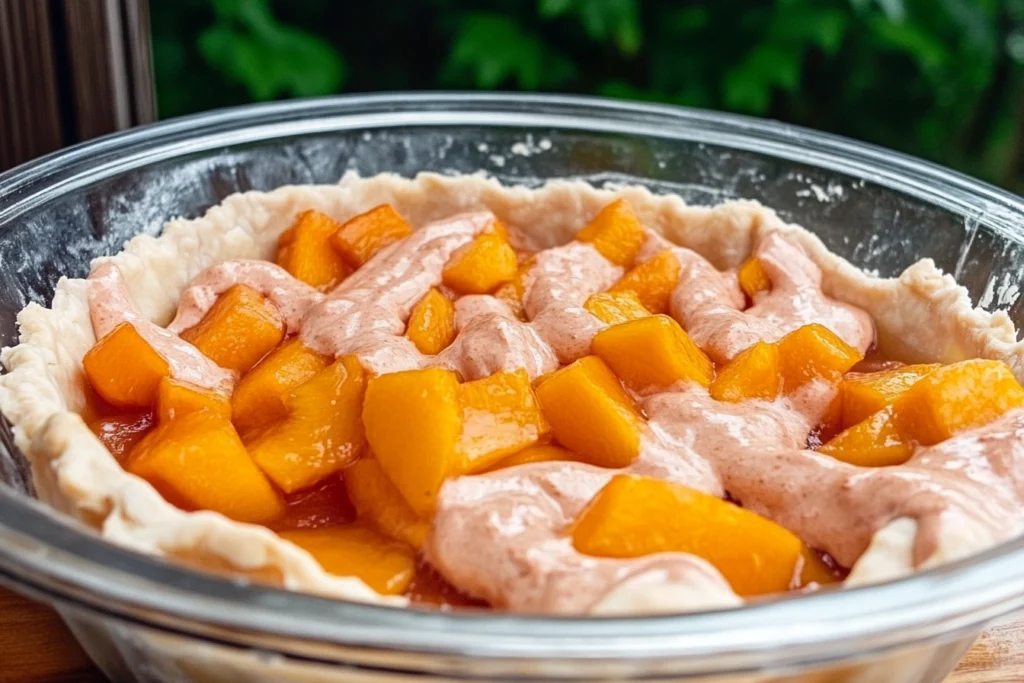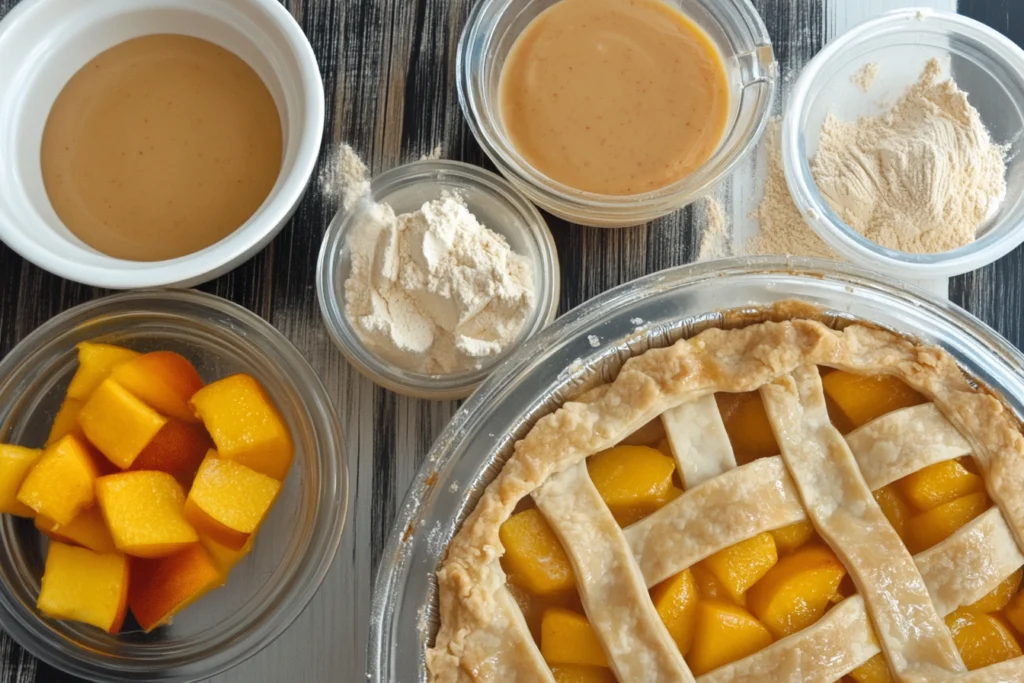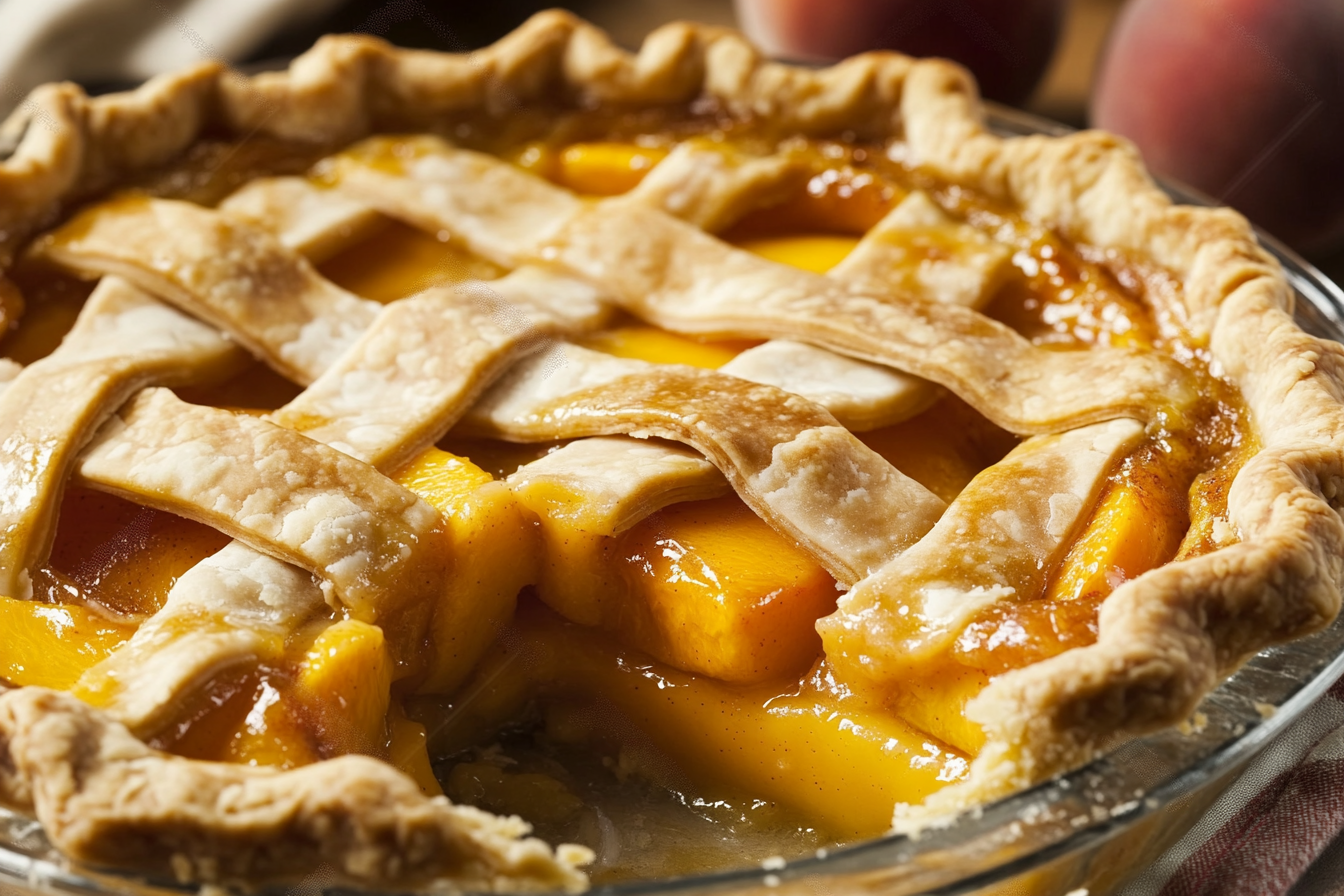Thickener for Peach Pie is essential to achieving the perfect consistency, as peaches release a lot of juice while baking. Choosing the right thickener ensures your pie filling is not too runny while maintaining a smooth, delicious texture. Common options include cornstarch, flour, tapioca, and arrowroot, each with its own benefits. Cornstarch creates a glossy, firm filling, while flour results in a denser texture. Tapioca is excellent for a clear, gel-like consistency, and arrowroot works well for a smooth, glossy finish. Selecting the best thickener for peach pie depends on your desired texture and personal preference.
Why Do You Need a Thickener in Peach Pie?
Preventing a Runny Pie Filling
Nothing is more disappointing than cutting into a peach pie only to see a watery filling spill out. The primary role of a thickener is to bind the juices released during baking, creating a cohesive texture that holds its shape when sliced. Without an effective thickener, even the most flavorful peaches can result in a soggy crust and an unappealing presentation.
Enhancing Texture and Consistency
A good thickener does more than absorb excess liquid. It provides the silky, velvety texture that defines a perfect pie filling. Thickeners also ensure that each bite offers a balanced combination of tender peaches and a smooth, slightly firm base.
Understanding the Role of Juicy Fruits in Pie Fillings
Peaches as a High-Water-Content Fruit
Peaches are renowned for their juiciness, which makes them both a blessing and a challenge for bakers. While their abundant juices contribute to flavor, they also risk overwhelming the crust and creating a runny mess. This makes a proper thickener essential for controlling moisture levels.
Challenges of Maintaining the Perfect Pie Texture
When baked, peaches release even more liquid due to heat. This natural process, while enhancing the flavor, can result in a thin filling without the right stabilizing ingredient. Striking a balance between retaining the peach flavor and achieving a firm texture requires an understanding of thickeners and their properties.
Overview of Common Thickening Agents
Starch-Based Thickeners
Starches like cornstarch, tapioca, and flour are the most common thickeners used in pie fillings. They work by absorbing liquid and forming a gel-like structure when heated. Each starch has unique properties that affect the pie’s texture, clarity, and flavor.
Alternative Thickeners: Gels and Powders
For bakers seeking gluten-free or specialty options, thickeners like arrowroot powder, pectin, and gelatin are excellent choices. These alternatives can deliver superior results in terms of clarity and texture, making them a favorite for modern and traditional bakers alike.
The Best Options for Thickening Peach Pie Filling
Cornstarch: A Popular and Affordable Option
Cornstarch is a staple thickener in many kitchens due to its affordability and effectiveness. It creates a smooth, glossy finish in pie fillings, making it a popular choice for peach pies.
Pros and Cons of Cornstarch in Pie Recipes
- Pros:
- Creates a clear, glossy filling.
- Affordable and widely available.
- Neutral flavor that doesn’t overpower peaches.
- Cons:
- May break down under prolonged baking or acidic conditions.
- Overuse can result in a gluey texture.
Tips for Using Cornstarch Effectively
To avoid clumps, always mix cornstarch with sugar before adding it to your pie filling. Use moderate heat to ensure the starch activates without breaking down.
Tapioca: The Go-To for a Clear and Glossy Filling
Tapioca, derived from cassava root, is another popular thickener known for producing a glossy, translucent filling.
Types of Tapioca: Instant vs. Regular
- Instant tapioca: Easier to use, as it dissolves quickly.
- Regular tapioca pearls: Require soaking and grinding but offer a similar effect.
Best Practices for Incorporating Tapioca
For the best results, let your pie filling sit for 15–20 minutes after adding tapioca. This allows the starch to fully hydrate and prevents a gritty texture.
Flour: A Traditional and Accessible Thickener
Flour has long been a favorite thickener for pie fillings due to its simplicity and accessibility.
How Flour Compares in Texture and Taste
While flour thickens effectively, it can result in a slightly cloudy and heavier texture. It may not deliver the glossy finish that cornstarch or tapioca offers but remains a reliable choice for home bakers.
When to Use Flour for Thickening
Flour is ideal for rustic pies or recipes where a cloudy appearance won’t detract from the pie’s appeal. It also works well when paired with spices like cinnamon or nutmeg.
Arrowroot Powder: A Gluten-Free Alternative
Arrowroot powder is a versatile and gluten-free thickener that excels in pies requiring a clear filling.
Advantages of Arrowroot for Thickening
- Maintains clarity in the filling.
- Holds up well under acidic conditions.
- Works well at lower temperatures.
Situations Where Arrowroot Excels
Arrowroot is perfect for peach pies where you want to preserve the fruit’s natural color and flavor. It’s also an excellent choice for gluten-free baking.
Pectin and Gelatin: Specialty Thickeners
Pectin and gelatin are less commonly used but can be powerful tools for thickening pie fillings.
Enhancing Gel Structure in Pies
- Pectin: Creates a jam-like consistency, making it ideal for pies with a firm filling.
- Gelatin: Adds a slightly chewy texture and is best used in chilled or semi-frozen pies.
When and How to Use Pectin or Gelatin
Use pectin or gelatin when you want a filling that stays firm and cohesive. Dissolve these thickeners in warm liquid before adding them to your pie filling to ensure even distribution.
The Best Options for Thickening Peach Pie Filling (Continued)
Cornstarch: A Popular and Affordable Option (Continued)
Cornstarch works well with peaches because it activates at a relatively low temperature, allowing the natural flavors of the fruit to shine through. However, its effectiveness can diminish in highly acidic environments, such as pies with added citrus juices. This makes proper measurement critical.
Additional Tips for Using Cornstarch in Peach Pies
- Combine with Sugar: Prevents lumps and ensures even distribution.
- Don’t Overmix: Overmixing can break down the starch structure, causing the filling to thin out.
- Avoid Overbaking: Cornstarch loses thickening power if exposed to high heat for too long.
Tapioca: The Go-To for a Clear and Glossy Filling (Continued)
Tapioca creates a glossy, beautiful finish that highlights the bright color of peaches. Unlike cornstarch, tapioca maintains its structure even after reheating or freezing, making it an excellent choice for pies stored for later use.
Specific Benefits of Instant Tapioca
- Hydrates quickly, saving time during preparation.
- Produces a smooth consistency without grittiness.
- Works well in combination with other thickeners for customized textures.

Flour: A Traditional and Accessible Thickener (Continued)
Flour thickens peach pie filling by absorbing the liquid and forming a subtle gel-like structure during baking. While it might not offer the crystal-clear look of cornstarch or tapioca, its earthy, muted appearance suits rustic or farmhouse-style desserts.
Additional Considerations for Flour as a Thickener
- Flavor Impact: Flour has a slightly nutty flavor that can complement the pie, but overuse may make the filling taste chalky.
- Proportion Control: Too much flour can result in a pasty texture, so stick to the recipe’s recommended quantity.
Arrowroot Powder: A Gluten-Free Alternative (Continued)
Arrowroot powder’s neutral flavor and ability to work under various conditions make it a standout thickener for peach pies with special dietary considerations. Unlike cornstarch, arrowroot doesn’t break down in acidic environments, ensuring a stable filling.
Key Tips for Using Arrowroot Powder
- Avoid Dairy: Arrowroot can become slimy when mixed with milk or cream.
- Pairing with Fruits: Works especially well with peaches, berries, and tropical fruits.
- Low-Heat Application: Activates at lower temperatures, preserving the fruit’s integrity.
Pectin and Gelatin: Specialty Thickeners (Continued)
Pectin and gelatin provide unique solutions for bakers aiming for professional-quality fillings. While not as common as starch-based options, these thickeners excel in creating firmer textures.
Practical Tips for Using Pectin or Gelatin
- Pectin: Use in small quantities to avoid an overly firm filling. Ideal for pies served cold or at room temperature.
- Gelatin: Bloom gelatin in warm water before mixing it with the pie filling. This ensures smooth integration and prevents clumps.
How to Decide on the Perfect Thickener for Your Pie
Choosing the best thickener for your peach pie depends on several factors, including your desired texture, flavor profile, and dietary needs. Here’s a closer look at how to make an informed choice.
Factors to Consider When Choosing a Thickener
Recipe Requirements and Desired Texture
Ask yourself:
- Do you prefer a smooth and glossy filling or a rustic appearance?
- How firm should the filling be? Cornstarch and tapioca are great for silky textures, while pectin and flour can create firmer results.
Balancing Sweetness and Neutral Flavors
Different thickeners impact the pie’s flavor profile:
- Cornstarch and arrowroot are neutral, preserving the natural sweetness of peaches.
- Flour adds a subtle nutty note that complements spices like cinnamon or nutmeg.
Adjusting Thickener Quantities for Peach Pie
Calculating the Right Amount for Juicy Peaches
The juicier the fruit, the more thickener you’ll need:
- Cornstarch: Use about 2 tablespoons per 4 cups of peaches.
- Tapioca: 3 tablespoons of instant tapioca per 4 cups of peaches.
- Flour: 1/4 cup for every 4 cups of fruit.
- Arrowroot: 1–2 tablespoons for 4 cups of peaches.
How to Test and Adjust During Baking
- Monitor the pie as it bakes. If the filling appears too watery, let it bake longer to thicken.
- Allow the pie to cool completely. The filling often sets further as it cools.
Combining Thickeners for Better Results
Blending Starches for Ideal Consistency
Combining thickeners can yield superior results:
- Cornstarch + Tapioca: Adds glossiness and stability.
- Flour + Arrowroot: Balances texture and flavor.
Tips for Experimenting with Ratios
- Start with equal parts of two thickeners and adjust based on your preferred consistency.
- Always test small batches before committing to a full recipe.
Troubleshooting Common Thickener Issues
Avoiding Lumps or Clumps in the Filling
- Cornstarch or Flour: Mix with sugar or a small amount of cold water before adding.
- Tapioca: Allow time for proper hydration to avoid a gritty texture.
Correcting Overly Thick or Thin Pie Fillings
- If the filling is too thick, add a splash of fruit juice or water during baking.
- For overly thin fillings, mix a slurry of your chosen thickener with cold water and stir it into the filling.
How to Decide on the Perfect Thickener for Your Peach Pie
Factors to Consider When Choosing a Thickener
Recipe Requirements and Desired Texture
Your desired texture plays a key role in selecting the right thickener. Whether you want a glossy filling or a more rustic look, the thickener defines the experience of your pie.
- Glossy and Smooth: Cornstarch and tapioca create a clear and silky filling, perfect for pies where the peach color shines.
- Rustic and Hearty: Flour or pectin offers a thicker, cloudier appearance, ideal for farmhouse-style desserts.
- Firm and Sliceable: Gelatin is the best choice when you need a pie that holds its shape during serving.
Balancing Sweetness and Neutral Flavors
The choice of thickener also influences the pie’s flavor:
- Neutral Thickeners: Cornstarch, arrowroot, and tapioca don’t overpower the peaches’ natural sweetness.
- Flavor-Enhancing Options: Flour adds subtle nutty undertones that pair well with spices like cinnamon or nutmeg.
- Pectin’s Sweet Boost: Provides a jam-like consistency that amplifies the fruit’s flavor.

Adjusting Thickener Quantities for Peach Pie
Calculating the Right Amount for Juicy Peaches
The juiciness of peaches varies by ripeness and variety. Adjust your thickener proportion based on the fruit’s water content:
- Cornstarch: 2 tablespoons per 4 cups of peaches.
- Tapioca: 3 tablespoons for the same amount.
- Flour: 1/4 cup for 4 cups of peaches.
- Arrowroot: 1–2 tablespoons for a glossy, stable filling.
Testing and Adjusting During Baking
Observe the pie as it bakes:
- Bubbling filling indicates the thickener is activated.
- Let the pie cool completely; the filling will thicken further as it sets.
For runny fillings after baking, add a thickener slurry made of starch and cold water. Return the pie to the oven to cook the slurry.
Combining Thickeners for Better Results
Blending Starches for Ideal Consistency
Using a combination of thickeners often leads to superior results:
- Cornstarch + Tapioca: Produces a glossy, sliceable filling.
- Arrowroot + Pectin: Balances firmness and clarity, ideal for peach pies.
Tips for Experimenting with Ratios
Start with a 50:50 ratio of two thickeners and adjust based on your desired texture. Keep track of your results to perfect your recipe.
Troubleshooting Common Thickener Issues
Avoiding Lumps in the Filling
Lumpy fillings are a common issue but can be prevented:
- Pre-Mix: Combine thickeners with sugar or cold water before adding them to the peaches.
- Stir Gently: Overmixing can break down the thickener’s structure.
Fixing Overly Thick or Thin Fillings
- Too Thick: Gradually stir in a small amount of warmed fruit juice or water until the texture improves.
- Too Thin: Create a slurry of thickener and cold water. Slowly add it to the bubbling filling.
Enhancing Peach Pie Flavor with Thickeners
Infusing Flavor
Elevate your pie by incorporating additional flavors into your thickener:
- Vanilla Extract: Adds warmth and depth.
- Spices: Cinnamon, nutmeg, or cardamom enhance peach flavors.
- Citrus Zest: Lemon or orange zest brightens the filling.
Complementary Ingredients
Pair thickeners with ingredients like brown sugar or almond extract for an extra layer of flavor.
Freezing Peach Pie with the Right Thickeners
Best Thickeners for Freezing
Some thickeners perform better when frozen:
- Tapioca and arrowroot retain their structure and clarity after freezing.
- Cornstarch, however, tends to break down, leading to watery fillings.
Pro Tip: Cool the pie completely before freezing to avoid moisture buildup.
Serving Suggestions and Toppings
Enhance your peach pie with creative topping ideas:
- Classic Whipped Cream: Adds a light, airy touch.
- Vanilla Ice Cream: Provides a cool, creamy contrast.
- Crumble Topping: Adds texture and complements the smooth filling.
Serve slightly warm for a comforting dessert or chilled for a refreshing twist.
Final Tips for Perfect Peach Pie
- Adjust thickeners based on the juiciness of your peaches.
- Experiment with combining thickeners to achieve the best texture.
- Let the pie cool completely before serving to allow the filling to set.
By mastering the art of thickening, you can create peach pies that are as visually stunning as they are delicious.
FAQs
- What’s the best thickener for juicy peaches?
Tapioca absorbs liquids well without becoming gummy. - Can I freeze a peach pie with cornstarch?
Cornstarch may break down after freezing. Use tapioca or arrowroot for better results. - Why is my filling gritty?
Undercooked tapioca or flour can cause grittiness. Allow the pie to bake fully. - What’s the best thickener for gluten-free pies?
Arrowroot is gluten-free and provides excellent results. - How do I avoid clumps in the filling?
Mix the thickener with sugar before adding it to the fruit. - Can I mix different thickeners?
Yes, blending thickeners often produces the best consistency. - How do I fix a watery pie after baking?
Reheat the pie and stir in a slurry of starch and cold water. - What thickener is best for a clear filling?
Tapioca or arrowroot delivers the clearest results. - Why is my filling cloudy?
Flour-based thickeners create a cloudier texture compared to starches like tapioca. - How much thickener should I use for canned peaches?
Reduce the thickener slightly, as canned peaches have less water than fresh ones.
Related Article : Can you use canned peaches instead of fresh peaches?

